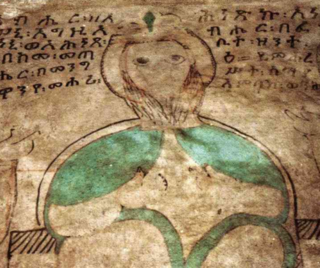Related Research Articles

Abune Tekle Haymanot was an Ethiopian saint and monk mostly venerated as a hermit. He was the Abuna of Ethiopia who founded a major monastery in his native province of Shewa. He is significant for being the only Ethiopian saint popular both amongst Ethiopians and outside that country. Tekle Haymanot "is the only Ethiopian saint celebrated officially in foreign churches such as Rome and Egypt." His feast day is 30 August, and the 24th day of every month in the Ethiopian calendar is dedicated to Tekle Haymanot.

Yekuno Amlak ; throne name Tesfa Iyasus was Emperor of Ethiopia, from 1270 to 1285, and the founder of the Solomonic dynasty, which lasted until 1974. He was a ruler from Bete Amhara who became the Emperor of Ethiopia following the defeat of the last Zagwe king.
Five men known as sons of Yagbe'u Seyon ruled as Emperor of Ethiopia in succession between 1294 and 1299. Their names were:

Amda Seyon I, also known as Amda Tsiyon I, throne name Gebre Mesqel, was Emperor of Ethiopia from 1314 to 1344 and a member of the Solomonic dynasty.
Newaya Krestos was Emperor of Ethiopia from 1344 to 1372, and a member of the Solomonic dynasty. He was the eldest son of Amda Seyon I.
Zara Yaqob was Emperor of Ethiopia, and a member of the Solomonic dynasty who ruled under the regnal name Qostantinos I. He is known for the Geʽez literature that flourished during his reign, the handling of both internal Christian affairs and external wars with Muslims, along with the founding of Debre Birhan as his capital. He reigned for 34 years and 2 months.
Amda Seyon II was Emperor of Ethiopia briefly during 1494, and a member of the Solomonic dynasty. He was the infant son of Eskender and a second wife of Eskender's father Baeda Maryam I.

Yagbe'u Seyon, throne name Salomon, was Emperor of Ethiopia from 18 June 1285 to 1294, and a member of the Solomonic dynasty. He succeeded his father Yekuno Amlak.
Eskender was Emperor of Ethiopia and a member of the Solomonic dynasty. His throne name was Kwestantinos II. He was the son of Emperor Baeda Maryam I by his wife Queen Romna. His early years would see the jostling for power between the nobility and the ecclesiastical elite.

Abuna is the honorific title used for any bishop of the Ethiopian Orthodox Tewahedo Church as well as of the Eritrean Orthodox Tewahedo Church. It was historically used solely for the head of the Coptic Orthodox Church in Ethiopia during the more than 1000 years when the Coptic Patriarchate of Alexandria appointed only one bishop at a time to serve its Ethiopian flock. When referred to without a name following, it is Abun, and if a name follows, it becomes Abuna.

Iyasus Mo'a was an Ethiopian saint of the Ethiopian Orthodox Tewahedo Church; his feast day is 5 December. In life he was an Ethiopian monk and abbot of Istifanos Monastery in Lake Hayq of Amba Sel.

Istifanos Monastery is a monastery in Ethiopia, located in Lake Hayq. The church structure was built around the 9th century by the Aksumite king Dil Na'od. In the 13th century, the church was converted into a monastery, in large part due to the work of Saint Iyasus Mo'a and later Emperor Yekuno Amlak.
Jamal ad-Din was a governor of Ifat. He was the son of Nahwi b. Mansur b. Umar Walashma and a brother of Haqq ad-Din I.
Ethiopian ecclesiastical titles refers to the offices of the Ethiopian Orthodox Tewahedo Church, a hierarchical organization. Some of the more important offices are unique to it.
Abba 'Ěnbāqom born Ab'ul-Fath was a Yemeni polyglot, religious leader of the Ethiopian Orthodox Tewahedo Church, translator, and author of the Anqaṣa Amin. As Abbot at the leading monastery of Debre Libanos he became the Echage, the second highest ecclesiastical office, as well as head of all Ethiopian monasteries, and was often regarded as the most influential person in the Ethiopian Church.
Salama II was Abuna, or head of the Ethiopian Orthodox Church from 1348 to 1388. During his tenure a number of translations into the Ge'ez language appeared, which has resulted with him being remembered as "Abba Salama, the Translator."

Giyorgis of Segla, also known as Giyorgis of Gasicha or Abba Giyorgis, was an Ethiopian Oriental Orthodox monk, saint, and author of religious books.
Bartalomewos of Ethiopia was an Abuna, or head of the Ethiopian Orthodox Church from 1398/99 to sometime after 1434; he succeeded Abuna Salama II. His tenure was a period marked by a series of doctrinal disputes in the Church, and at one point Bartalomewos was accused of denying the threefold nature of the Holy Trinity. Emperor Yeshaq appointed a committee to investigate this serious charge, whose members included graduates of the school at Istifanos Monastery in Lake Hayq.
Abuna Mikael was an abuna or head of the Ethiopian Orthodox Church in the 12th century. According to tradition, Mikael anointed seven kings, dedicated 1,009 churches, and appointed 27,000 priests.
Biqulzar also spelled as Baqulzar or Bequl zar was a historical region located in eastern Ethiopia. According to Taddesse Tamrat, the state was positioned east of the Awash River however historian Hussein Ahmed, proposes it was a general term for districts east of Amhara region in the fourteenth century.
References
- ↑ Taddesse Tamrat, "The Abbots of Däbrä-Hayq 1248-1535", Journal of Ethiopian Studies, 8 (1970), p. 97 n. 45
- ↑ Margery Perham, The Government of Ethiopia, second edition (London: Faber and Faber, 1969), p. 104
- ↑ Taddesse Tamrat, "Abbots of Däbrä-Hayq", pp. 96f
- ↑ Taddesse Tamrat, "Abbots of Däbrä-Hayq", p. 98 and note